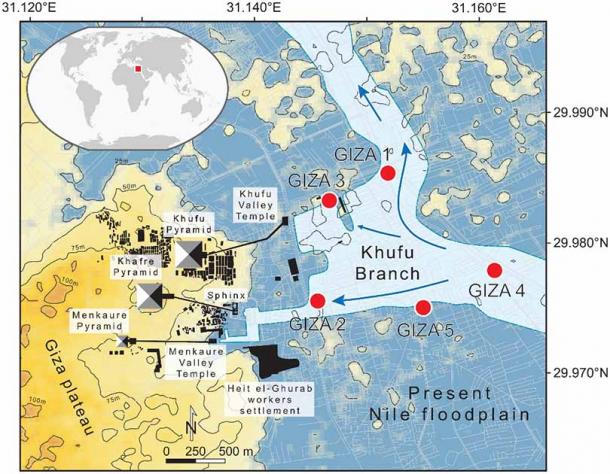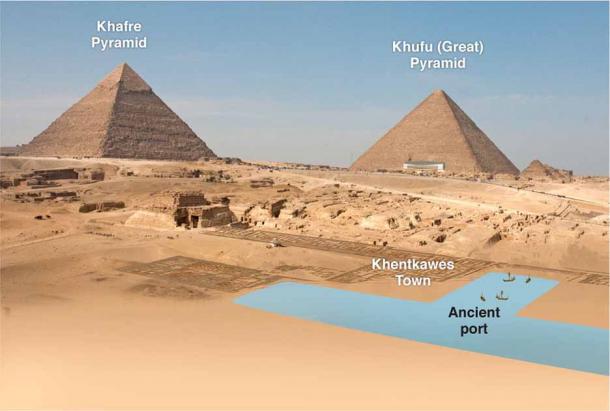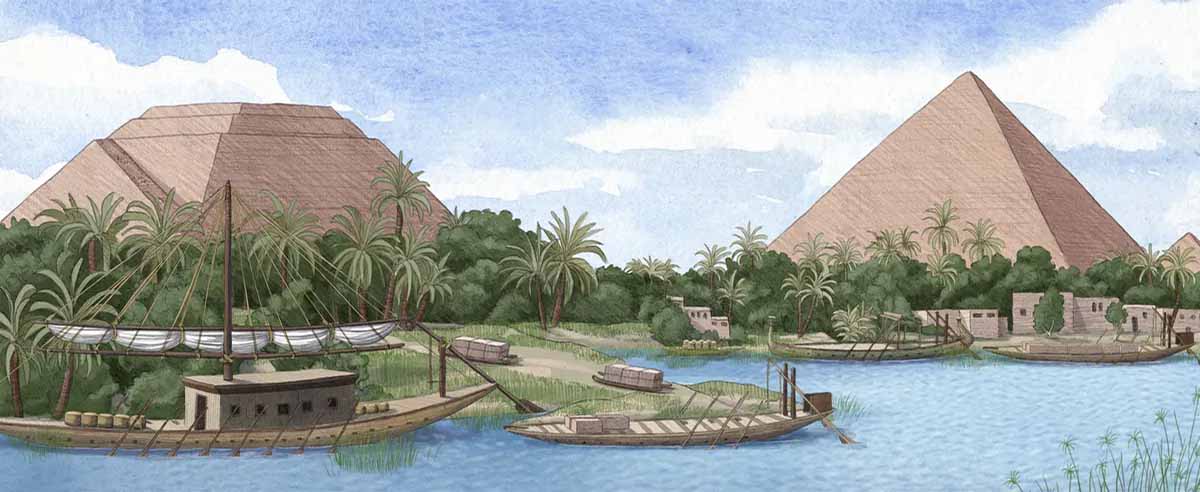How Egyptian Pyramid Builders Moved Construction Materials by Water
Regardless of how they were constructed, the Egyptian pyramids of the Giza Plateau represent one of mankind’s most astonishing engineering achievements. The logistical challenges of moving millions of tons of building materials to the site would have been immense, yet the mere existence of these ancient marvels proves the Egyptians found a way to do it. And evidence is building that the Giza pyramid builders relied on water transportation to move heavy quarry stones.
Archaeological and urban development excavations in the region have revealed the existence of a series of canals and basins that experts are certain were used to carry materials - including the limestone and granite that make up the bulk of the pyramids - to the Giza site. These man-made structures would have harnessed the flow of the Nile and created a direct connection between Africa’s most famous river and the Giza Plateau. This passage would have been perfect for the pyramid builders to save time and money.

The recent PNAS study on the Giza pyramid builders used previous research and pollen samples to show that canals and boats carried construction materials from quarries for Egypt’s great pyramids. This illustration shows all the kinds of boats the Egyptians had in ancient times and how they were used. (New York Public Library / Public domain)
Giza’s Pyramid Builders Used Canals To Move Stones
In ancient Egyptian manuscripts known as the Wadi-al-Jarf papyri, the design of the water diversion project that allowed for the transport of materials to the Giza Plateau was described in detail. These documents relate how limestone was quarried at a site known as Toura and transported to the construction site of the Great Pyramid of Khufu, the largest of the three Giza pyramids. The canal route that connected the quarry with Giza covered a distance of 11 miles (17 kilometers), and archaeological discoveries in the area have confirmed that the basins, ports, and canals described in the Wadi-al-Jarf papyri really did exist.
This type of interlocking system of waterways would have been absolutely necessary to transport heavy construction materials to the Giza building site. The Nile is located five miles (eight kilometers) to the east of the pyramids, and that would have made overland transport of millions of tons of building materials impossible. Key to the operation of the canal system was a now-extinct tributary of the Nile known as the Khufu branch, which ran along the western edge of the Giza floodplain. This natural channel would have comprised the final link in the Nile-Giza canal network.
- 4,500-Year-Old Double Tomb for Pharaoh Purifiers Revealed On Giza Plateau
- 2000-year-old Canals Give Life to Lima as Ancient Structures Utilized to Solve Water Crisis
Up to now, however, no analysis had been performed to demonstrate that water levels on the Khufu branch were high enough to make the passage of transport boats possible during Egypt’s Fourth Dynasty of the Old Kingdom (2,686 to 2,160 BC), when the pyramids were allegedly erected.
That oversight has finally been rectified, thanks to the efforts of a team of French scientists who’ve just published a new study of the ancient Khufu branch in the Proceedings of the National Academy of Sciences. The scientists have confirmed that water levels on this Nile tributary would have been sufficient during Fourth Dynasty days to create a permanent link with the artificial canal system, making it possible for supply boats to carry millions of tons of limestone and granite directly to the Giza Plateau.

The recent PNAS study on the Giza pyramid builders relied on Giza floodplain pollen cores to show ancient water or canal water levels. The two cores used to reconstruct Holocene variations in Khufu-branch levels (cores G1 and G4) are located where the Khufu basin was connected to the Nile. (PNAS)
Tracking Ancient Plant Growth to Reveal the Facts
So how exactly were the French scientists able to calculate water levels of a river branch that dried up thousands of years ago?
To obtain this knowledge, they relied on an indirect but ingenious method that gave them accurate information about what water levels on the Khufu tributary would have been in ancient times.
On the ancient floodplain surrounding this now-defunct section of the Nile River network, the scientists collected pollen grains from different sediment levels. They did so by drilling and removing pollen core samples from a location just east of the pyramid complex.
Using this approach, they were able to track changes in the historical growth patterns of 61 different plants that can thrive on floodplains, depending on the frequency of flooding that occurs (which in turn depends on water levels of the flooding river or tributary). Putting together the pieces of a complex puzzle, they were able to calculate water levels in the Nile’s Khufu branch over 8,000 years of Egyptian history, extending well past the point in time when the pyramids were allegedly constructed.
It turns out water levels on the Khufu were highest during the African Humid Period, which lasted from 14,800 to 5,500 years ago. From this time on water levels began to recede gradually, but the Khufu branch remained at an elevated level throughout the Old Kingdom Period.
The Great Pyramid of Giza, which is said to have been constructed as a monument to the pharaoh Khufu (and hence the name, Khufu branch), was completed approximately 4,500 years ago, as were its two partners, the pyramids of Khafre and Menkaure. At this time the Khufu tributary would have been navigable, making the movement of heavy construction materials (primarily limestone and granite) a viable enterprise.

Dr. Mark Lehner of the Ancient Egypt Research Associates has done a lot of work on the ancient port of Giza and how it was used by the pyramid builders. (Dr. Mark Lehner / Ancient Egypt Research Associates, Inc.)
Celebrating Two Works of Engineering Genius
The authors of the article in the Proceedings of the National Academy of Sciences explained precisely how the complex river-and-canal system worked on the Giza end.
“The fluvial-port-complex hypothesis postulates that pyramid builders cut through the western levee of the Khufu branch of the Nile and dredged basins down to river depth, in order to harness the annual seven-meter rise of the [Nile] flood like a hydraulic lift, bringing the higher water levels to the base of the Giza Plateau,” they wrote. “In this way, it was possible to transport supplies and building materials directly to the pyramid complex.”
- The Sphinx of Giza: Who Built the World’s Most Famous Sphinx in Egypt?
- Archaeologists Announce that New Discoveries Solve Mystery of How the Great Pyramid Was Built
The canal-and-river system would have allowed for the transport of materials and people over much longer distances as well. It was built to facilitate monument construction of all types in ancient Egypt, and it also connected Giza with Egyptian cities in the region. The Nile’s annual floods provided all the water that was needed for such a system to work once the Egyptians had figured out how best to capture it and use it for their benefit.
While not a match for the pyramids themselves, this interlocking system of canals, basins, ports, and natural river tributaries that unlocked the transportation potential of the Nile was itself a work of engineering genius of the pyramid builders.
Without such a system for redirecting water to where it was needed Egypt’s monument-building activities would have been severely restricted.
Top image: An artist's illustration showing how a now-defunct arm of the Nile River known as the Khufu branch once reached the pyramids, which the Giza pyramid builders used to great advantage to move heavy construction materials according the recent PNAS pollen core study. Source: Alex Boersma / PNAS
By Nathan Falde




















Comments
Edit: the posthumous dumbing down of maxwells equations
infinitesimal waveparticles comprise what we call home the earth
manipulatable by thought ability supressed in humans since birth
Does noone remember the coral castle creator n his sound(vibration) based antigravity? I guess not
Telsa showed us how certain frequencies resonate with themselves...
I guess too many people dont wish to accept that our electron based technology(maxwells dumbed down equations) is NOT the top of the pile.
infinitesimal waveparticles comprise what we call home the earth
manipulatable by thought ability supressed in humans since birth
The subterranean structure of the Great Pyramid shows a crude, primitive stone well of sorts, as the earliest part of its construction, which among other aspects suggests it was built progressively over time. Three key dates in the timeline: 1) when the earliest construction happened, 2) when it was finally completed (as the form we now see it), and 3) when it was surface-damaged? Each one above, as well as from #3 to now, may be separated by tens of thousands of years. Need radiometric dating, double-blind, multiple sources, multiple facilities.
Nobody gets paid to tell the truth.
“ … 5 miles … overland transport of millions of tons of building materials impossible” ??
For the ancient Egyptians this would be child’s play. Anyway, take a look at the Pyramid of Djedefre, Khufu’s son, at Abu Roash. It’s 9 miles from the Nile, about 5 miles Northwest of Khufu’s pyramid, and it’s on a plateau about 500 feet above the Nile, about 300 feet higher than the Great Pyramid’s plateau (200 feet). The Giza plateau descends to about 20 feet above the Nile. Abu Roash descends to about 100 feet above the Nile.